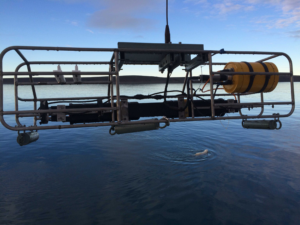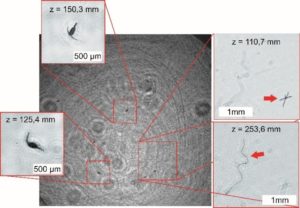Marine Optical Sensors of Bioparticles on the Base of DHC-technology of Ьeasurement
 Developing set of sensors is based on DHC-technique (Digital Holographic Camera). DHC-technology provides registration, measurement, recognition and classification of suspended particles of different origin including biological ones in the habitat. DHC sensors are targeted on hydrobiological measurements in situ with obtaining information in real time and using of modern communication channels and different media.
Developing set of sensors is based on DHC-technique (Digital Holographic Camera). DHC-technology provides registration, measurement, recognition and classification of suspended particles of different origin including biological ones in the habitat. DHC sensors are targeted on hydrobiological measurements in situ with obtaining information in real time and using of modern communication channels and different media.
The world ocean is not only the habitat and the area of economic activity of human, but also a place whose ecological well-being determines the fate of mankind on Earth. In this sense, continuous monitoring of the ocean features with the use of various sensors (marine sensorics) is very urgent and responsible.
Plankton of World Ocean is a beginning of the food chain, so its condition is an important factor of biodiversity and sustainability. It`s use in the natural environment as a bioindicator allows early determination of the environment resistance to various factors associated, for example, with human economic activity. Therefore, the task of digitizing plankton data is no less important than the digitization of hydrophysical properties.
To solve this problem, it is necessary to overcome some technological barriers:
– big data technologies adopted in the world oceanology should be applied to the ocean hydrobiology (global initiative ICES\ PICES), which requires hydrobiological unmanned probe operating in a global information network,
– ocean research technologies as well as the wold marine sensorics do not have the sensors solving the problem of plankton classification in situ , in real time, and with a sufficient amount of data.
 Plankton digital sensors created in TSU are new (from the point of view of measurement methods) measuring tools of marine sensorics with allowing to perform the detecting, counting, measurement of geometrical parameters, recognition and analysis of the moving activity of plankton organisms and are focused on the following tasks of environmental monitoring:
Plankton digital sensors created in TSU are new (from the point of view of measurement methods) measuring tools of marine sensorics with allowing to perform the detecting, counting, measurement of geometrical parameters, recognition and analysis of the moving activity of plankton organisms and are focused on the following tasks of environmental monitoring:
– in situ construction of the distribution of plankton concentration in depth in real time,
– in situ classification of plankton according to taxonomical features for ecological monitoring, identification of bioresources, oceanological, hydrobiological researches with result obtained in real time in the mode of a continuous flow of data,
– in situ analysis of the behavior of plankton particles for the biotesting at hazardous sites, oceanological studies to obtain real-time results in a continuous flow of data.
The goals of the project are developing and market launch the series of marine optical sensors based on DHC-technology DHC, using the ocean research and development program in Russia and the BRICS countries, as a pilot site.
Project leader – Dyomin V. V., Vice-rector of Tomsk State University, head of the laboratory of radiophysical and optical methods for studying the environment
Federal State Autonomous Educational Institution of High Education
“National Research Tomsk State University», 36 Lenin Ave., Tomsk, Russia 634050.
To address operational issues:
Deputy leader: Polovcev Igor G., e-mail: polovcev_i@mail.ru
Mob. phone: + 7-923-427-27-01.

 Русский
Русский